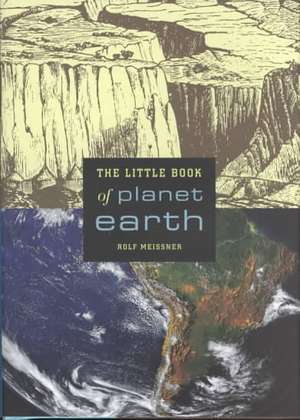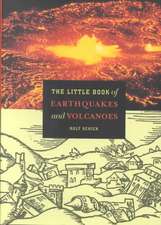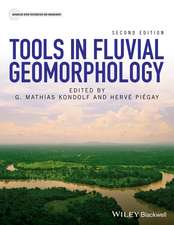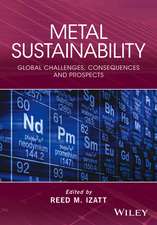The Little Book of Planet Earth: Little Book Series
Autor Rolf Meissneren Limba Engleză Hardback – 15 mar 2002
| Toate formatele și edițiile | Preț | Express |
|---|---|---|
| Paperback (1) | 133.00 lei 3-5 săpt. | |
| Springer – 10 dec 2010 | 133.00 lei 3-5 săpt. | |
| Hardback (1) | 135.46 lei 3-5 săpt. | |
| Springer – 15 mar 2002 | 135.46 lei 3-5 săpt. |
Preț: 135.46 lei
Nou
Puncte Express: 203
Preț estimativ în valută:
25.92€ • 27.21$ • 21.51£
25.92€ • 27.21$ • 21.51£
Carte disponibilă
Livrare economică 20 martie-03 aprilie
Preluare comenzi: 021 569.72.76
Specificații
ISBN-13: 9780387952581
ISBN-10: 0387952586
Pagini: 204
Ilustrații: XIV, 204 p.
Dimensiuni: 123 x 203 x 19 mm
Greutate: 0.37 kg
Ediția:2002
Editura: Springer
Colecția Copernicus
Seria Little Book Series
Locul publicării:New York, NY, United States
ISBN-10: 0387952586
Pagini: 204
Ilustrații: XIV, 204 p.
Dimensiuni: 123 x 203 x 19 mm
Greutate: 0.37 kg
Ediția:2002
Editura: Springer
Colecția Copernicus
Seria Little Book Series
Locul publicării:New York, NY, United States
Public țintă
Popular/generalCuprins
The Roots of Earth Sciences.- The Earth in the Context of Our Solar System.- The Formation of Earth and Moon.- The Interior of the Earth and the Role of Seismology.- Rotation and Shape, Gravity and Tides.- The Earth’s Magnetic Field.- Atom—Mineral—Rock.- The Early Ages.- Radioactive Dating.- Plate Tectonics.- The Crust of the Earth.- Formation of Mountains and Basins.- New Discoveries, New Concepts.- The Phanerozoic: The Last 600 Million Years.- Biological Evolution.- Epilogue Our limited resources.
Recenzii
From the reviews:
|"[The Little Book of Planet Earth] provides critical insights into the nature of Earth's composition, our understanding of Earth's magnetic field, and plate tectonics." Science News
"How did life on our planet evolve? How old is Earth? How was our solar system formed and, with it, our planet? These are big questions, but the answers are found in this small book that gives broad insights into earth science." Science News
"An amazing introduction to what scientific research through the past centuries up to the modern day has learned about our planet." The Bookwatch
"The book is a small miracle." New Scientist
"The Little Book of Planet Earth describes the geological evolution of Earth from its formation. … In this concise and engaging little book, the author introduces lay readers to the key topics in modern earth and planetary science: the creation of Earth and its moon, the role of seismology in analyzing Earth’s structure, the formation of mountain ranges and basins, the significance of Earth’s magnetic field, and more." (Science in Africa, October, 2002)
"The Little Book of Planet Earth by meteorologist and geophysicist Rolf Meissner is an amazing introduction to what scientific research through the past centuries up to the modern day has learned about our planet. From the origin of the solar system to plate tectonics to earth’s magnetic field and much more, chapters teach all about the Earth in straightforward, easy-to-understand language accessible to lay readers. Highly recommended for all readers … ." (Circulation, June, 2002)
"This small but delightful book should interest anyone curious about the planet he or she lives on. … Meissner treats this material in an interesting and easy-to-read style. But he does much more – he also describes the formation of Earth and its development. … There are numerous illustrations and photographsthroughout, along with a section on further reading. … Strongly recommended. General readers; lower- and upper-division undergraduates." (B. R. Parker, Choice, October, 2002)
"It is an up-to-date account of great breakthroughs in the earth sciences during the second half of the 20th century, that were published in top journals. … A very interesting work that satisfies one’s taste for understanding the basics of the science his professional occupation is based upon." (Michiel Dusar, Geologica Belgica, Vol. 5 (1-2), 2002)
"It’s a simple plan and excellently carried out, exploring early ideas about the origin of the Earth, then describing the Solar System and gradually narrowing the focus until reaching the core of the Earth itself. Meissner then retraces his path with fascinating explanations … . There are admirable illustrations, too. … the book is a small miracle." (Roy Herbert, New Scientist, May, 2002)
|"[The Little Book of Planet Earth] provides critical insights into the nature of Earth's composition, our understanding of Earth's magnetic field, and plate tectonics." Science News
"How did life on our planet evolve? How old is Earth? How was our solar system formed and, with it, our planet? These are big questions, but the answers are found in this small book that gives broad insights into earth science." Science News
"An amazing introduction to what scientific research through the past centuries up to the modern day has learned about our planet." The Bookwatch
"The book is a small miracle." New Scientist
"The Little Book of Planet Earth describes the geological evolution of Earth from its formation. … In this concise and engaging little book, the author introduces lay readers to the key topics in modern earth and planetary science: the creation of Earth and its moon, the role of seismology in analyzing Earth’s structure, the formation of mountain ranges and basins, the significance of Earth’s magnetic field, and more." (Science in Africa, October, 2002)
"The Little Book of Planet Earth by meteorologist and geophysicist Rolf Meissner is an amazing introduction to what scientific research through the past centuries up to the modern day has learned about our planet. From the origin of the solar system to plate tectonics to earth’s magnetic field and much more, chapters teach all about the Earth in straightforward, easy-to-understand language accessible to lay readers. Highly recommended for all readers … ." (Circulation, June, 2002)
"This small but delightful book should interest anyone curious about the planet he or she lives on. … Meissner treats this material in an interesting and easy-to-read style. But he does much more – he also describes the formation of Earth and its development. … There are numerous illustrations and photographsthroughout, along with a section on further reading. … Strongly recommended. General readers; lower- and upper-division undergraduates." (B. R. Parker, Choice, October, 2002)
"It is an up-to-date account of great breakthroughs in the earth sciences during the second half of the 20th century, that were published in top journals. … A very interesting work that satisfies one’s taste for understanding the basics of the science his professional occupation is based upon." (Michiel Dusar, Geologica Belgica, Vol. 5 (1-2), 2002)
"It’s a simple plan and excellently carried out, exploring early ideas about the origin of the Earth, then describing the Solar System and gradually narrowing the focus until reaching the core of the Earth itself. Meissner then retraces his path with fascinating explanations … . There are admirable illustrations, too. … the book is a small miracle." (Roy Herbert, New Scientist, May, 2002)













